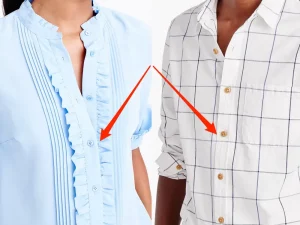 By Paul M
By Paul M
Much has been made recently of the question, “What is a man?” and the related but less important question, “What is a woman?” A little too much has been made, in fact, because many people have an interest in muddying the waters on what could be a relatively straightforward matter. It is time for Harry’s Place to stop ignoring the new realities and take its place on the right side of history.
For most of the human epoch there has been a simple, universally accepted answer to both of these questions: A man is a person whose shirt buttons are on the right side and whose buttonholes are on the left. A woman has shirts with the buttons on the left and the buttonholes on the right. Simple as it was, this observation served to sum up all anyone needed to know about human sex (or gender, which was the same thing).
Of course, in the modern world nothing is ever quite that simple. We now understand that some children never feel comfortable in the shirts assigned to them at birth. It is vitally important to affirm their needs and help them transition to a shirt of their choosing as soon as possible, preferably without telling their parents. Others may change their buttons at the onset of adolescence or even far into adulthood. Individuals may bury the awareness of their button-dysphoria only to have it burst out at a time of great stress, such as the looming prospect of a stiff prison term for violent crime. Some people suffer confusion when they dress in front of a mirror.
As people have become more willing to question their gender identity, some have started to experiment with other, more varied, possibilities. Both “two-spirit” and “bi” folk will generally have buttons and buttonholes on both sides: It’s not always easy to tell these variants apart. You may only discover which is which by making the wrong assumption in public, so it’s vitally important to ask for pronouns in order to avoid microaggression, which leads inevitably to thoughts of suicide, making you essentially a murderer. Gender-fluid individuals and the pansexual may have shirts with buttons and buttonholes distributed seemingly at random, but they may also switch between left- and right-buttoned shirts depending on which one they feel best expresses, on any given day, their chance of gaining the whip hand.
Then there are the agendered. These are people who feel that it’s oppressive and more than they can handle, to be expected to choose between left- and right-buttoning at all. They wear smocks. Whatever you do, don’t confuse them with the unbuttoned, who are either up for any kind of arrangement you care to name or merely too idle to do up their clothes.

Those with the most cutting-edge, progressive feelings (at the time of writing) wear shirts with either buttons or buttonholes on both sides (“outies” and “innies,” respectively). We don’t yet know what this means, as no one has worked up the courage to ask, but we expect to be informed once the gender theorists have come up with identities to go with these new presentations.
This, then, is the contemporary landscape of sex and gender. It is important that we all learn to navigate among the nuances of modern identity. To refuse is to out oneself as an obtuse and unfeeling pawn of the cisheteropatriarchy, a gammon who does violence by turning his back on diversity, inclusion and equity. On the other hand, you must understand that in absorbing the new etiquette you unmask your white supremacism. Did you not know that buttoned shirts are a trapping of the west? You are too quick to center your own sick parochialism.
In the words of commissars everywhere, You are fucked either way, Comrade. Devote your time to the study of the prevailing winds and trust yourself to the mercy of our new, true church. It will not be forthcoming.
Next week: The Pearly Kings & Queens—Toward a New Appreciation of Gender Flamboyance in Victorian England
